MORRIS DANCING
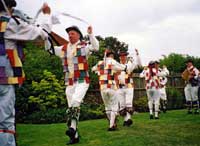 Maypole Dancing is often associated with dancing the Morris and especially with the Morris Dances of the Cotswolds (Oxfordshire and adjacent counties) although this may be just because both activities involve dancing and having a good time! Morris dancers often deck themselves out with ribbons and wave handkerchieves that catch the breeze and exaggerate their movements. They wear bells around their legs which ring in time with the music. The musical instruments of the Morris and even the tunes are often borrowed to make the Maypole Dance music.
Maypole Dancing is often associated with dancing the Morris and especially with the Morris Dances of the Cotswolds (Oxfordshire and adjacent counties) although this may be just because both activities involve dancing and having a good time! Morris dancers often deck themselves out with ribbons and wave handkerchieves that catch the breeze and exaggerate their movements. They wear bells around their legs which ring in time with the music. The musical instruments of the Morris and even the tunes are often borrowed to make the Maypole Dance music.
 You can add to the Maypole Dancing experience by providing lengths of ribbon that the dancers can use to decorate their clothing and bells tied on lengths of string but loose enough to ring freely to tie below the dancers' knees or at the ankles.
You can add to the Maypole Dancing experience by providing lengths of ribbon that the dancers can use to decorate their clothing and bells tied on lengths of string but loose enough to ring freely to tie below the dancers' knees or at the ankles.
JACK IN THE GREEN
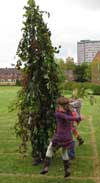 It is thought that this tradition dates back to the 16th Century and the making of garlands out of leaves, often for the Mayday celebrations. Eventually, the decorations became so large that they became the focus of the activity, covering the wearer completely. Perhaps the total disguise was why it seems that the character of the Jack in the Green later became associated with rowdiness and mischief.
It is thought that this tradition dates back to the 16th Century and the making of garlands out of leaves, often for the Mayday celebrations. Eventually, the decorations became so large that they became the focus of the activity, covering the wearer completely. Perhaps the total disguise was why it seems that the character of the Jack in the Green later became associated with rowdiness and mischief.
You can make a Jack in the Green outfit by creating a conical shaped structure of wire mesh and then attaching a broom handle to the point and decorating the outside of the mesh with short leafy branches. A strong person can get underneath the structure and hold it up by means of the broom handle. They can then dance in time with the maypole music or perhaps run around, scaring all those who dare to get in their way.
PROCESSIONS
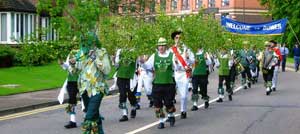 Another activity often happening at the same time as Maypole Dancing is the tradition of local community processions. The picture shows the Lichfield (Greenhill) Bower Procession, usually held in the later part of May. In this case, the dancers, who are formed up in two columns, crossing over to swap positions in time with the music, carry "bowers". These are branches of fresh birch, ash or oak which are waved in circles as the dance progresses.
Another activity often happening at the same time as Maypole Dancing is the tradition of local community processions. The picture shows the Lichfield (Greenhill) Bower Procession, usually held in the later part of May. In this case, the dancers, who are formed up in two columns, crossing over to swap positions in time with the music, carry "bowers". These are branches of fresh birch, ash or oak which are waved in circles as the dance progresses.
HOBBY HORSES
 If you are really industrious, you can make a Hobby Horse. Of course, it does not have to be a horse but can be any animal (or "beast") you can dream up.
If you are really industrious, you can make a Hobby Horse. Of course, it does not have to be a horse but can be any animal (or "beast") you can dream up.
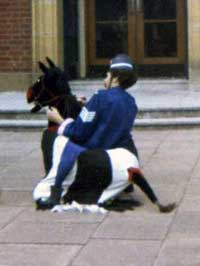 Your beast can be as simple as a head fastened to a broom handle with a wheel at the other end. The dancer stands astride of the broom handle. A more stylised version has the dancer holding up the broom handle beneath a skirt of material which covers them completely. In the most complex constructions the dancer appears to be astride the animal.
In the more elaborate versions, it has become the tradition to articulate the mouth of the beast so that it can snap its jaws in time with the music.
Your beast can be as simple as a head fastened to a broom handle with a wheel at the other end. The dancer stands astride of the broom handle. A more stylised version has the dancer holding up the broom handle beneath a skirt of material which covers them completely. In the most complex constructions the dancer appears to be astride the animal.
In the more elaborate versions, it has become the tradition to articulate the mouth of the beast so that it can snap its jaws in time with the music.
Some believe that the hobby horse's job is to link the audience more closely with the dancers' performance by moving seamlessly from the performance of the dance to being among the watchers. Others suggest that it is another way to create mischief and excitement.
THE GREEN MAN
 The Green Man is another disguised character. His history dates back a very long way and his head, with leaves coming out of his mouth, can often be seen staring down from the tops of column in old churches. Like the other disguised characters, he can be a source of good or mischief.
The Green Man is another disguised character. His history dates back a very long way and his head, with leaves coming out of his mouth, can often be seen staring down from the tops of column in old churches. Like the other disguised characters, he can be a source of good or mischief.
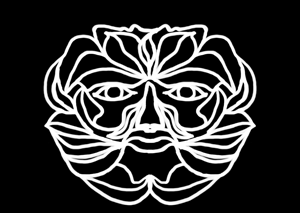 You can make your own Green Man character in a variety of ways. If you have a face-painter they can design thier own faces or you can download the template by clicking on the image on the right and paint your own face, then cut it out and attach elastic to make a mask. Of course, you can also make a full outfit like the one above.
You can make your own Green Man character in a variety of ways. If you have a face-painter they can design thier own faces or you can download the template by clicking on the image on the right and paint your own face, then cut it out and attach elastic to make a mask. Of course, you can also make a full outfit like the one above.
THE MAY QUEEN
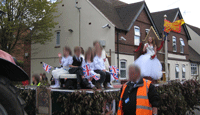 It was the tradition in many villages and towns to crown a May Queen. The picture shown is of the 2013 Lichfield (Greenhill) Bower Queen. The selected person is crowned shortly after the start of the Bower Procession and then processes through the city on the back of a flat-bed truck. The queen and "attendants" are given gifts to mark their appointment and attend various official engagements during the subsequent year.
It was the tradition in many villages and towns to crown a May Queen. The picture shown is of the 2013 Lichfield (Greenhill) Bower Queen. The selected person is crowned shortly after the start of the Bower Procession and then processes through the city on the back of a flat-bed truck. The queen and "attendants" are given gifts to mark their appointment and attend various official engagements during the subsequent year.
 Maypole dancing is most often associated with May Day celebrations all over the world but also happens at other times of celebration. Originally commemorating the arrival of spring, May Day was a holiday with much merry-making. A young girl was selected as May Queen often with a May King. They were “crowned” and presided over the festivities which included feasting, singing, music-making and dancing. The album, Maypole Dance Music is available on iTunes. Click on the button to be transferred to the iTunes Store or click here to buy a CD.
Maypole dancing is most often associated with May Day celebrations all over the world but also happens at other times of celebration. Originally commemorating the arrival of spring, May Day was a holiday with much merry-making. A young girl was selected as May Queen often with a May King. They were “crowned” and presided over the festivities which included feasting, singing, music-making and dancing. The album, Maypole Dance Music is available on iTunes. Click on the button to be transferred to the iTunes Store or click here to buy a CD.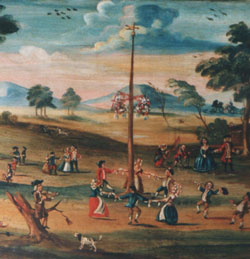 The celebration of May Day and maypole dancing was banned for a short time in England during the 17th Century but has continued to be enjoyed since that time.
The celebration of May Day and maypole dancing was banned for a short time in England during the 17th Century but has continued to be enjoyed since that time. The dances were often led by Morris Dancers playing the traditional tunes of the region. Today, the music usually features fiddle, pipe, tabor, accordion and concertina. More >>
The dances were often led by Morris Dancers playing the traditional tunes of the region. Today, the music usually features fiddle, pipe, tabor, accordion and concertina. More >>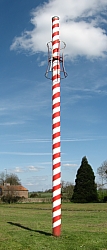 It is critical that the maypole does not wobble or fall over once it is erected. Make sure that there is enough space for the dancers to move around the maypole. It must be secured at the base so that it will remain in place while the dancers tug on the ribbons. In general, the more dancers, the taller the maypole. A 3 to 5 m tall wooden maypole should be at least 40mm diameter. Strong plastic pipe is another option for the maypole.
It is critical that the maypole does not wobble or fall over once it is erected. Make sure that there is enough space for the dancers to move around the maypole. It must be secured at the base so that it will remain in place while the dancers tug on the ribbons. In general, the more dancers, the taller the maypole. A 3 to 5 m tall wooden maypole should be at least 40mm diameter. Strong plastic pipe is another option for the maypole.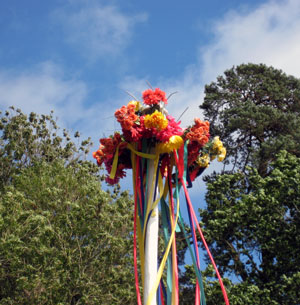


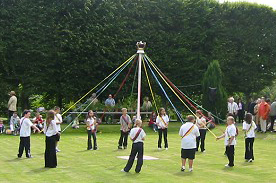 The step to use for music based on jigs or reels is a lilting walk or skip. For hornpipe rhythms use a step-hop-step-hop alternating from one foot to the other. For waltz-time music, take 3 even paces for each waltz bar of music.
The step to use for music based on jigs or reels is a lilting walk or skip. For hornpipe rhythms use a step-hop-step-hop alternating from one foot to the other. For waltz-time music, take 3 even paces for each waltz bar of music. To get used to using the ribbons, make sure that all the dancers are facing in the same direction and holding their ribbon in the hand furthest from the maypole. The hand nearest to the maypole is used to guide the ribbon over other dancers as they pass each other but, in this first ribbon dance, everybody will be going in the same direction. Now start the music and all dance around the maypole in the same direction without overtaking. Eventually there is no length of ribbon left as it has become wrapped around the maypole, at which time the order is given to reverse your steps and unwind the maypole. If you unwind without any knots you have successfully completed your first dance.
To get used to using the ribbons, make sure that all the dancers are facing in the same direction and holding their ribbon in the hand furthest from the maypole. The hand nearest to the maypole is used to guide the ribbon over other dancers as they pass each other but, in this first ribbon dance, everybody will be going in the same direction. Now start the music and all dance around the maypole in the same direction without overtaking. Eventually there is no length of ribbon left as it has become wrapped around the maypole, at which time the order is given to reverse your steps and unwind the maypole. If you unwind without any knots you have successfully completed your first dance. Purchase using PayPal (no account required - just pay by credit/debit card)
Purchase using PayPal (no account required - just pay by credit/debit card) Maypole Dancing is often associated with dancing the Morris and especially with the Morris Dances of the Cotswolds (Oxfordshire and adjacent counties) although this may be just because both activities involve dancing and having a good time! Morris dancers often deck themselves out with ribbons and wave handkerchieves that catch the breeze and exaggerate their movements. They wear bells around their legs which ring in time with the music. The musical instruments of the Morris and even the tunes are often borrowed to make the Maypole Dance music.
Maypole Dancing is often associated with dancing the Morris and especially with the Morris Dances of the Cotswolds (Oxfordshire and adjacent counties) although this may be just because both activities involve dancing and having a good time! Morris dancers often deck themselves out with ribbons and wave handkerchieves that catch the breeze and exaggerate their movements. They wear bells around their legs which ring in time with the music. The musical instruments of the Morris and even the tunes are often borrowed to make the Maypole Dance music. You can add to the Maypole Dancing experience by providing lengths of ribbon that the dancers can use to decorate their clothing and bells tied on lengths of string but loose enough to ring freely to tie below the dancers' knees or at the ankles.
You can add to the Maypole Dancing experience by providing lengths of ribbon that the dancers can use to decorate their clothing and bells tied on lengths of string but loose enough to ring freely to tie below the dancers' knees or at the ankles. It is thought that this tradition dates back to the 16th Century and the making of garlands out of leaves, often for the Mayday celebrations. Eventually, the decorations became so large that they became the focus of the activity, covering the wearer completely. Perhaps the total disguise was why it seems that the character of the Jack in the Green later became associated with rowdiness and mischief.
It is thought that this tradition dates back to the 16th Century and the making of garlands out of leaves, often for the Mayday celebrations. Eventually, the decorations became so large that they became the focus of the activity, covering the wearer completely. Perhaps the total disguise was why it seems that the character of the Jack in the Green later became associated with rowdiness and mischief. Another activity often happening at the same time as Maypole Dancing is the tradition of local community processions. The picture shows the Lichfield (Greenhill) Bower Procession, usually held in the later part of May. In this case, the dancers, who are formed up in two columns, crossing over to swap positions in time with the music, carry "bowers". These are branches of fresh birch, ash or oak which are waved in circles as the dance progresses.
Another activity often happening at the same time as Maypole Dancing is the tradition of local community processions. The picture shows the Lichfield (Greenhill) Bower Procession, usually held in the later part of May. In this case, the dancers, who are formed up in two columns, crossing over to swap positions in time with the music, carry "bowers". These are branches of fresh birch, ash or oak which are waved in circles as the dance progresses. If you are really industrious, you can make a Hobby Horse. Of course, it does not have to be a horse but can be any animal (or "beast") you can dream up.
If you are really industrious, you can make a Hobby Horse. Of course, it does not have to be a horse but can be any animal (or "beast") you can dream up. Your beast can be as simple as a head fastened to a broom handle with a wheel at the other end. The dancer stands astride of the broom handle. A more stylised version has the dancer holding up the broom handle beneath a skirt of material which covers them completely. In the most complex constructions the dancer appears to be astride the animal.
In the more elaborate versions, it has become the tradition to articulate the mouth of the beast so that it can snap its jaws in time with the music.
Your beast can be as simple as a head fastened to a broom handle with a wheel at the other end. The dancer stands astride of the broom handle. A more stylised version has the dancer holding up the broom handle beneath a skirt of material which covers them completely. In the most complex constructions the dancer appears to be astride the animal.
In the more elaborate versions, it has become the tradition to articulate the mouth of the beast so that it can snap its jaws in time with the music. The Green Man is another disguised character. His history dates back a very long way and his head, with leaves coming out of his mouth, can often be seen staring down from the tops of column in old churches. Like the other disguised characters, he can be a source of good or mischief.
The Green Man is another disguised character. His history dates back a very long way and his head, with leaves coming out of his mouth, can often be seen staring down from the tops of column in old churches. Like the other disguised characters, he can be a source of good or mischief.
 It was the tradition in many villages and towns to crown a May Queen. The picture shown is of the 2013 Lichfield (Greenhill) Bower Queen. The selected person is crowned shortly after the start of the Bower Procession and then processes through the city on the back of a flat-bed truck. The queen and "attendants" are given gifts to mark their appointment and attend various official engagements during the subsequent year.
It was the tradition in many villages and towns to crown a May Queen. The picture shown is of the 2013 Lichfield (Greenhill) Bower Queen. The selected person is crowned shortly after the start of the Bower Procession and then processes through the city on the back of a flat-bed truck. The queen and "attendants" are given gifts to mark their appointment and attend various official engagements during the subsequent year.